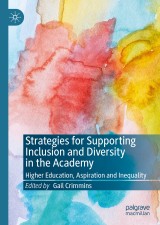Details

Strategies for Supporting Inclusion and Diversity in the Academy
Higher Education, Aspiration and Inequality|
149,79 € |
|
| Verlag: | Palgrave Macmillan |
| Format: | |
| Veröffentl.: | 29.06.2020 |
| ISBN/EAN: | 9783030435936 |
| Sprache: | englisch |
Dieses eBook enthält ein Wasserzeichen.
Beschreibungen
This book explores tried and tested strategies that support student and faculty engagement and inclusion in the academy. These strategies are anchored by a brief exploration of the history and effect/s of exclusion and deprivilege in higher education. However, while many publications exploring academic inequality focus on the causes and impacts of structural, psychological and cultural exclusion based on racism, sexism, classism and ableism, they rarely engage in interventions to expose and combat such de/privilege. Capturing examples of inclusive practices that are as diverse as student and faculty populations, these strategies can be easily translated and employed by organisations, collectives and individuals to recognise and combat social and academic exclusion within higher education environments.
Preface; Gail Crimmins.- Chapter 1. Don't throw out the baby with the bathwater: Statistics can create impetus to address educational inequity; Gail Crimmins.- SECTION I. Supporting racial diversity in the academy.- Chapter 2. Promoting race equality and supporting ethnic diversity in the academy: The UK experience over two decades; Andrew Pilkington.- Chapter 3. Reflecting on representation: Exploring critical tensions within doctoral training programmes in the UK; Rebecca Gordon and Lakshmi S. Bose.- Chapter 4. Killing the Indigene: Interrogating the support of First Nations' diversity in the modern university; Sandy O'Sullivan.- Chapter 5. Refugees in neoliberal universities; Aura Lounasmaa.- Chapter 6. A critical-relational approach to community development that increases well-being, learning outcomes and retention of international students; Athena Lathouras.- SECTION II. Engendering gender diversity in higher education.- Chapter 7. Thriving in the academy: Culturally responsive mentoring for Black women's early career success; Tamara Bertrand-Jones, Jesse R. Ford, Devona F. Pierre and Denise Davis-Maye.- Chapter 8. Women and leadership: Strategies of gender inclusion in institutions of higher education in India; Karuna Chanana.- Chapter 9. Mainstreaming gender into the quality assurance of higher education programs; Tània Verge.- Chapter 10. Success for LGBT college and university students; Kristen A. Renn.- Chapter 11. Trans inclusive higher education: Strategies to support trans, non-binary and gender diverse students; Stephanie Mckendry and Matson Lawrence.- SECTION III. Re'class'ifying academia.- Chapter 12. The Coffee Club: An initiative to support mature and non-traditional higher education students in Wales; Dawn Mannay and Michael R.M. Ward.- Chapter 13. Using a funds of knowledge approach to engage diverse cohorts through active and personally relevant learning; Sally Tazewell.- Chapter 14. The impact of stigma, placement instability and individual motivation on successful transitions in and through university for care experienced young people; Gemma Allnatt.- Chapter 15. Murdoch's aspirations and pathways for university (MAP4U) project: Developing and supporting low SES students' aspirations for higher education participation using school-based university outreach programs; Antoinette Geagea and Judith MacCallum.- SECTION IV. Disabling the barrier of dis/ability in higher education.- Chapter 16. Inclusive higher education for college students with intellectual disability; Lauren Bethune-Dix, Erik W. Carter, Cassandra Hall, Elise McMillan, John Cayton, Tammy Day, Megan Vranicar, Chad Bouchard, Lindsay Krech, Jenny Gustafson, Emilee Bauer The Women Who Write; Linda Henderson, Alison L. Black, Gail Crimmins and Janice K. Jones.- Chapter 17. Student Suggestions for Improving Learning at University for Those with Learning Challenges/Disability; Susan Grimes.- Chapter 18. A Case Study of the Educational Experience ofAdult Students with Dyslexia across Five TAFE Institutes in Queensland; Jacques Caskey.- Chapter 19. Inclusion in Practice: Operationalising Principles of Inclusion and Diversity; Gail Crimmins.
<b>Gail Crimmins </b>is Senior Lecturer at the University of the Sunshine Coast, Australia. Her research interests include gender inequity and the often unheard narratives of women, and uses of feminist approaches to research.
"This book brings together a comprehensive and diverse range of perspectives and experiences of strategies and approaches that will be of value to anyone who works in delivery, leadership or support of diversity and inclusion in higher education. Its authentic voice, combined with a rich range of methodologies and personal insights helps the authors to bring complex concepts to life in a manner which is honest, thoughtful and challenging."<div>—<b>Professor Sarah Sharples</b>, Pro-Vice Chancellor for Equality, Diversity and Inclusion, University of Nottingham, UK</div><div><br></div>"Crimmins’ excellent collection is a treasure trove of irrefutable statistical facts and figures that blows away the myth that diversity and inclusion policies have closed the equalities gap in higher education. Powerful fuel for policy makers and social justice educators passionate about creating a truly global academy where all can flourish regardless of race, gender, class, sexuality, and (dis)ability."<div>—<b>Professor Heidi Safia Mirza</b>, Goldsmiths College, University of London, UK</div><div><br></div><div>This book explores tried and tested strategies that support student and faculty engagement and inclusion in the academy. These strategies are anchored by a brief exploration of the history and effect/s of exclusion and deprivilege in higher education. However, while many publications exploring academic inequality focus on the causes and impacts of structural, psychological and cultural exclusion based on racism, sexism, classism and ableism, they rarely engage in interventions to expose and combat such de/privilege. Capturing examples of inclusive practices that are as diverse as student and faculty populations, these strategies can be easily translated and employed by organisations, collectives and individuals to recognise and combat social and academic exclusion within higher education environments. <br></div><div><br></div><div><b>Gail Crimmins </b>is Senior Lecturerat the University of the Sunshine Coast, Australia. Her research interests include gender inequity and the student experience in the academy and uses of feminist approaches to research. </div><div><br></div>
Provides a history of exclusion and deprivilege in higher education based on aspects of identity Fills an important gap in the market by focusing on solutions and strategies rather than exclusion itself Illuminates diverse and concrete practices that can be deployed to combat such de/privilege
Diese Produkte könnten Sie auch interessieren:

University Science and Mathematics Education in Transition

von: Ole Skovsmose, Paola Valero, Ole Ravn Christensen

96,29 €















